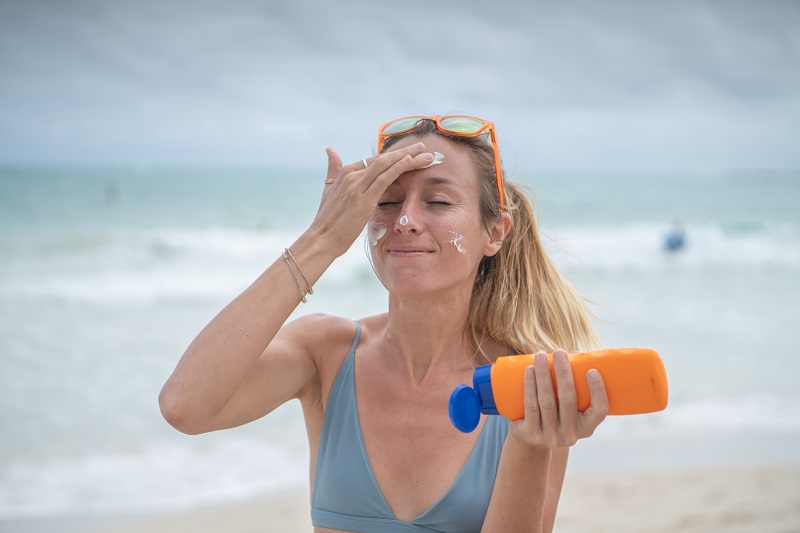Are There Harmful Ingredients in Your Sunscreen?

August 13, 2021
Growing up, you may have only used sunscreen when you were at the beach, but today, you might be one of the countless Americans who apply SPF protection each morning as part of your daily routine.
Because people are wearing sunscreen more often than ever, it has prompted researchers to scrutinize the ingredients within sunscreen to ensure that what we’re putting on our skin is safe and effective. Although some ingredients are considered safer than others, doctors and researchers still strongly recommend sunscreen use, especially if you’ll be outside during peak sunlight hours, between 10 a.m. and 4 p.m.
“Sunscreen helps to protect your skin from ultraviolet radiation, which lowers your long-term risk of skin cancer, the most commonly diagnosed type of cancer,” says Margaret H Hager, M.D., a family medicine specialist, HMH Medical Group Primary Care-Forked River. “People shouldn’t avoid wearing sunscreen out of concern about certain ingredients; they should consider what ingredients are in their sunscreen and perhaps choose other products with different ingredients.”
More Research is Needed on Certain Sunscreen Ingredients
In 2019, the U.S. Food and Drug Administration (FDA) ruled that it needed to get more information on 12 ingredients within sunscreen to determine whether they are safe and effective. It did not say that these ingredients are unsafe:
- avobenzone
- cinoxate
- dioxybenzone
- ensulizole
- homosalate
- meradimate
- octinoxate
- octisalate
- octocrylene
- oxybenzone
- padimate O
- sulisobenzone
Certain experts recommend avoiding the use of sunscreen containing oxybenzone. Some research has shown that the chemical is absorbed through the skin, where it may interfere with endocrine activity and hormones, particularly among children and possibly among pregnant women. The American Academy of Pediatrics recommends that parents shouldn’t use sunscreen with oxybenzone on children.
Also in 2019, the FDA named two sunscreen ingredients that are not safe. They shouldn’t be included in sunscreen formulations sold today, but if you have an old container of sunscreen lying around, look at the ingredients and toss it if it contains:
- PABA
- trolamine salicylate
Concerns About Benzene in Some Sunscreen Products
In May 2021, an online pharmacy that tests products for quality assurance released a report which found that levels of the chemical benzene were in certain batches of sunscreen products that they tested. Benzene is a component of cigarette smoke and gasoline, and it’s been shown to cause cancer, such as leukemia. It’s not added to sunscreen products purposely; rather, it’s believed that contamination during the manufacturing process led to the introduction of benzene in certain products.
Some researchers have questioned the methods that were used in the benzene-sunscreen report. Others have pointed out that the benefits of wearing sunscreen outweigh the risks of possible benzene exposure.
“Skin cancer is much more prevalent than the cancers associated with benzene, and people shouldn’t assume that the sunscreen that they have in their homes is from the specific batches that were tested and found to contain some benzene,” says Dr. Hager. “People shouldn’t avoid sunscreen because of news coverage of this report. They may not realize it, but they already come into contact with benzene in their daily lives, whenever they inhale car exhaust or second-hand smoke.”
Seek Out Safe Sunscreen Ingredients
In 2019, the FDA also recognized two sunscreen ingredients as safe and effective:
- Zinc oxide
- Titanium dioxide
Both ingredients are mineral-based. They work by creating a physical barrier between your skin and ultraviolet rays, helping to keep UV light from burning or damaging the skin.
Zinc oxide and titanium dioxide may not be as well-liked as other sunscreen ingredients, because they don’t blend in well; they sit on the surface of the skin, typically giving you a whitish sheen, no matter how well you try to rub it in.
If you prefer, you may still use sunscreens containing ingredients that the FDA wants more information about. However, if you’re pregnant or have children, you may want to avoid formulations containing oxybenzone.
Next Steps & Resources:
- Meet our source: Margaret H Hager, M.D.
- To make an appointment with Dr. Hager or a doctor near you, call 800-822-8905 or visit our website.
The material provided through HealthU is intended to be used as general information only and should not replace the advice of your physician. Always consult your physician for individual care.






